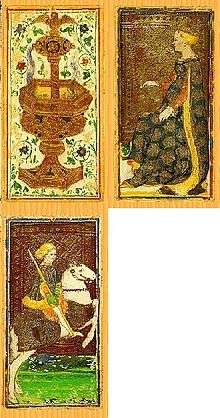Tarot
The tarot (/ˈtæroʊ/; first known as trionfi and later as tarocchi, tarock, and others) is a pack of playing cards, used from the mid-15th century in various parts of Europe to play games such as Italian tarocchini and French tarot. In the late 18th century, it began to be used for divination in the form of tarotology/cartomancy.
Like common playing cards, the tarot has four suits (which vary by region: French suits in Northern Europe, Latin suits in Southern Europe, and German suits in Central Europe). Each suit has 14 cards, ten cards numbering from one (or Ace) to ten and four face cards (King, Queen, Knight, and Jack/Knave). In addition, the tarot has a separate 21-card trump suit and a single card known as the Fool. Depending on the game, the Fool may act as the top trump or may be played to avoid following suit.[1]
François Rabelais mentions tarau as one of the games played by Gargantua in his Gargantua and Pantagruel;.[2]
Tarot cards are used throughout much of Europe to play card games. In English-speaking countries, where these games are not played, tarot cards are used primarily for divinatory purposes.[1] Occultists call the trump cards and the Fool "the major arcana" while the ten pip and four court cards in each suit are called minor arcana. The cards are traced by some occult writers to ancient Egypt or the Kabbalah but there is no documented evidence of such origins or of the usage of tarot for divination before the 18th century.[1]
Etymology
The word tarot and German Tarock derive from the Italian tarocchi, the origin of which is uncertain. There are many theories.[3] The singular term is tarocco, which means a type of blood orange in modern Italian. One theory relates to the Taro River in northern Italy; the game may have originated in Milan or Bologna.[4] Other writers believe it comes from the Arabic word طرق turuq, which means 'ways'.[5] Alternatively, it may be from the Arabic ترك taraka, 'to leave, abandon, omit, leave behind'.[6]
History
Playing cards first entered Europe in the late 14th century, most likely from Mamluk Egypt, with suits of Batons or Polo sticks (commonly known as Wands by those practicing occult or divinatory tarot), Coins (commonly known as disks, or pentacles in occult or divinatory tarot), Swords, and Cups. These suits were very similar to modern tarot divination decks and are still used in traditional Italian, Spanish and Portuguese playing card decks.[7]
The first documented tarot pack was recorded between 1430 and 1450 in Milan, Ferrara and Bologna when additional trump cards with allegorical illustrations were added to the common four-suit pack. These new decks were called carte da trionfi, triumph cards, and the additional cards known simply as trionfi, which became "trumps" in English. These cards are documented in a written statement in the court records in Florence, in 1440. The oldest surviving tarot cards are from fifteen decks painted in the mid 15th century for the Visconti-Sforza family, the rulers of Milan.[8] During the 16th-century, a new game played with a standard deck but sharing the same name (triomphe) was quickly becoming popular. This coincided with the older game being renamed tarocchi.[1]
Early decks

Picture-card packs are first mentioned by Martiano da Tortona probably between 1418 and 1425, since the painter he mentions, Michelino da Besozzo, returned to Milan in 1418, while Martiano himself died in 1425. He describes a deck with 16 cards with images of the Greek gods and suits depicting four kinds of birds. However the 16 cards were obviously regarded as "trumps" as, about 25 years later, Jacopo Antonio Marcello called them a ludus triumphorum, or "game of trumps".[9]
Special motifs on cards added to regular packs showed philosophical, social, poetical, astronomical, and heraldic ideas, Roman/Greek/Babylonian heroes, as in the case of the Sola-Busca-Tarocchi (1491)[1] and the Boiardo Tarocchi poem, written at an unknown date between 1461 and 1494.[10]
Fragments of two playing card decks from Milan (the Brera-Brambilla and Cary-Yale-Tarocchi), made around 1440, survive. Three documents dating from 1 January 1441 to July 1442, use the term trionfi. The document from January 1441 is regarded as an unreliable reference; however, the same painter, Sagramoro, was commissioned by the same patron, Leonello d'Este, as in the February 1442 document. The game seemed to gain in importance in the year 1450, a Jubilee year in Italy.
Three sets were made for members of the Visconti family.[11] The first deck, and probably the prototype, is called the Cary-Yale Tarot (or Visconti-Modrone Tarot) and was created between 1442 and 1447 by an anonymous painter for Filippo Maria Visconti.[11] The cards (only 67) are today held in the Cary collection of the Beinecke Rare Book and Manuscript Library at Yale University, in New Haven, Connecticut.[12] The most famous was painted in the mid-15th century, to celebrate Francesco Sforza and his wife Bianca Maria Visconti, daughter of the duke Filippo Maria. Probably, these cards were painted by Bonifacio Bembo or Francesco Zavattari between 1451 and 1453.[11] Of the original cards, 35 are in The Morgan Library & Museum, 26 are at the Accademia Carrara, thirteen are at the Casa Colleoni,[11] and four: The Devil, The Tower, The Knight of Coins, and the 3 of Swords, are lost or were never made. This "Visconti-Sforza" deck, which has been widely reproduced, reflects conventional iconography of the time to a significant degree.[13]
Hand-painted tarot cards remained a privilege of the upper classes and, although a Dominican preacher inveighed against the evil inherent in cards (chiefly owing to their use in gambling) in a sermon in the 14th century,[14] no routine condemnations of tarot were found during its early history.[1]
Because the earliest tarot cards were hand-painted, the number of the decks produced is thought to have been small. It was only after the invention of the printing press that mass production of cards became possible. Decks survive from this era from France, and the most popular pattern is the Tarot de Marseille[15] such as the Jean Dodal Tarot (Lyon) and the Jean Noblet Tarot (Paris) for example.
Tarot card games
The original purpose of tarot cards was to play games, the first rules appearing in the manuscript of Martiano da Tortona before 1425, and the next from the year 1637. The game of tarot has many cultural variations. Tarocchini has survived in Bologna and there are still others played in Piedmont and Sicily, but in Italy the game is generally less popular than elsewhere.
The 18th century saw tarot's greatest revival, during which it became the most popular card game in Europe, played everywhere except the British Isles, the Iberian peninsula, and the Ottoman Balkans.[16] French tarot experienced a revival beginning in the 1970s and France has the strongest tarot gaming community. Regional tarot games—often known as tarock, tarok, or tarokk are widely played in central Europe within the borders of the former Austro-Hungarian empire.
Divinatory, esoteric, and occult tarot
Divination using playing cards is recorded as early as 1540, though the cards are used only to select a random oracle and have no meaning in themselves. A manuscript from 1750 (Pratesi Cartomancer) documents rudimentary divinatory meanings for the cards of the tarot. In 1765, Giacomo Casanova wrote in his diary that his Russian mistress frequently used a deck of cards for divination.[17]
Varieties
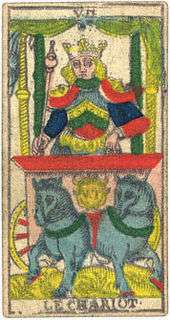
A variety of tarot designs exist and a number of typical regional patterns have emerged. Historically, one of the most important designs is the one usually known as the Tarot de Marseille. This standard pattern was the one studied by Court de Gébelin, and cards based on this style illustrate his Le Monde primitif. Some current editions of cards go back to a deck of a particular Marseille design that was printed by Nicolas Conver in 1760. Other regional styles include the "Swiss" Tarot. This one substitutes Juno and Jupiter for the Papess, or High Priestess and the Pope, or Hierophant. In Florence an expanded deck called Minchiate was used. This deck of 97 cards includes astrological symbols including the four elements, as well as traditional tarot motifs.
Some decks exist primarily as artwork; and such art decks sometimes contain only the 22 trump cards.
French suited tarot decks
French suited tarot cards began to appear in Germany during the 18th century. The first generation of French suited tarots depicted scenes of animals on the trumps and were thus called "Tiertarock" decks ('Tier' being German for 'animal'). Card maker Göbl of Munich is often credited for this design innovation. Current French suited tarot decks come in these patterns:
- The Industrie und Glück (Industry and Luck) tarock deck of Central Europe uses Roman numerals for the trumps. It is sold with 54 cards; the 5 to 10 of the red suits and the 1 to 6 of the black suits are removed.
- The Cego deck is used in Germany's Black Forest bordering France and has 54 cards organized in the same fashion as the Industrie und Glück. Its trumps use Arabic numerals but within centered indices.
- The Tarot Nouveau has 78 cards and is commonly played in France. Its trumps use Arabic numerals in corner indices.
The illustrations of French suited tarot trumps depart considerably from the older Italian suited design. The Renaissance allegorical motifs were abandoned for new themes or simply just whimsical pictures of daily life. With very few exceptional recent cases such as the "Tarocchi di Alan", "Tarot of Reincarnation" and the "Tarot de la Nature", French suited tarot cards are nearly exclusively used for card games.
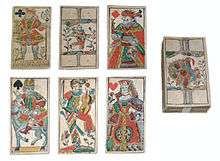 Example of 18th century "Tiertarock" or animal tarot.
Example of 18th century "Tiertarock" or animal tarot.- Industrie und Glück Tarock trumps
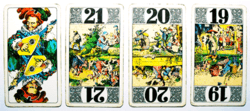 Cego trumps
Cego trumps- Tarot Nouveau trumps circa 1910
German suited tarot deck

German suited decks for Württemberg, Brixental, and Bavarian tarock are different. They have 36 cards, ranging from 6 to 10, Under Knave (Unter), Over Knave (Ober), King, and Ace. These use Ace-Ten ranking, like Klaverjas, where Ace is the highest followed by 10, King, Ober, Unter, then 9 to 6. The heart suit is the default trump suit.[1] The deck is also used to play Schafkopf.
Italo-Portuguese suited tarot deck
The Tarocco Siciliano is the only deck to use the so-called Portuguese suit system which uses Spanish pips but intersects them like Italian pips.[18] It changes some of the trumps, and has a card labeled Miseria (destitution). It omits the Two and Three of coins, and numerals one to four in clubs, swords and cups: it thus has 64 cards but the One of coins is not used, being the bearer of the former stamp tax. The cards are quite small and not reversible.[9]
Non-occult Italian-suited tarot decks
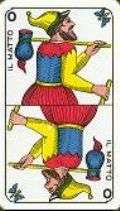
These were the oldest form of tarot deck to be made, being first devised in the 15th century in northern Italy. The occult tarot decks are based on decks of this type. Three decks of this category are still used to play certain games:
- The Tarocco Piemontese consists of the four suits of swords, batons, cups and coins, each headed by a king, queen, cavalier and jack, followed by the pip cards for a total of 78 cards. Trump 20 outranks 21 in most games and the Fool is numbered 0 despite not being a trump.
- The Swiss 1JJ Tarot is similar, but replaces the Pope with Jupiter, the Popess with Juno, and the Angel with the Judgement. The trumps rank in numerical order and the Tower is known as the House of God. The cards are not reversible like the Tarocco Piemontese.
- The Tarocco Bolognese omits numeral cards two to five in plain suits, leaving it with 62 cards, and has somewhat different trumps, not all of which are numbered and four of which are equal in rank. It has a different graphical design than the two above as it was not derived from the Tarot de Marseille.
Occult tarot decks
Etteilla was the first to issue a tarot deck specifically designed for occult purposes. In keeping with the misplaced belief that such cards were derived from the Book of Thoth, Etteilla's tarot contained themes related to ancient Egypt.
The 78-card tarot deck used by esotericists has two distinct parts:
- The Major Arcana (greater secrets), or trump cards, consists of 22 cards without suits: The Magician, The High Priestess, The Empress, The Emperor, The Hierophant, The Lovers, The Chariot, Strength, The Hermit, Wheel of Fortune, Justice, The Hanged Man, Death, Temperance, The Devil, The Tower, The Star, The Moon, The Sun, Judgement, The World, and The Fool. Cards from The Magician to The World are numbered in Roman numerals from I to XXI, while The Fool is the only unnumbered card, sometimes placed at the beginning of the deck as 0, or at the end as XXII.
- The Minor Arcana (lesser secrets) consists of 56 cards, divided into four suits of 14 cards each; ten numbered cards and four court cards. The court cards are the King, Queen, Knight and Page/Jack, in each of the four tarot suits. The traditional Italian tarot suits are swords, batons/wands, coins and cups; in modern tarot decks, however, the batons suit is often called wands, rods or staves, while the coins suit is often called pentacles or disks.
The terms "major arcana" and "minor arcana" were first used by Jean-Baptiste Pitois (also known as Paul Christian) and are never used in relation to Tarot card games.
Tarot is often used with the study of the Hermetic Qabalah.[19] In these decks there are Kabbalistic illustrations, most inspired by the "Rider-Waite" deck. The first deck to include completely illustrated suit cards was the 15th century Sola-Busca deck.[20]
Older decks such as the Visconti-Sforza and Marseilles are less detailed than modern ones. A Marseilles type deck has repetitive motifs on the pip cards, similar to Italian or Spanish playing cards, as opposed to the full scenes found on "Rider-Waite" style decks. These more simply illustrated "Marseilles" style decks are also used esoterically, for divination, and for game play, though the French card game of tarot is now generally played using a relatively modern 19th century design of German origin. Such playing tarot decks generally have twenty one trump cards with genre scenes from 19th century life, a Fool, and have court and pip cards that closely resemble today's French playing cards.
The Marseilles' numbered minor arcana cards do not have scenes depicted on them; rather, they sport a geometric arrangement of the number of suit symbols (e.g., swords, rods/wands, cups, coins/pentacles) corresponding to the number of the card (accompanied by botanical and other non-scenic flourishes), while the court cards are often illustrated with flat, two-dimensional drawings.
In contrast to the Thoth deck's colorfulness, the illustrations on Paul Foster Case's B.O.T.A. Tarot deck are black line drawings on white cards; this is an unlaminated deck intended to be colored by its owner.
Other esoteric decks include the hermetic Golden Dawn Tarot, which claims to be based on a deck by S.L. MacGregor Mathers.
The variety of decks in use is almost endless, and grows yearly. For instance, cat-lovers may have the Tarot of the Cat People. The Tarot of the Witches and the Aquarian Tarot retain the conventional cards with varying designs. The Tree of Life Tarot's cards are stark symbolic catalogs; and The Alchemical Tarot, created by Robert M. Place, combines traditional alchemical symbols with tarot images.
These contemporary divination decks change the cards to varying degrees. For example, the Motherpeace Tarot is notable for its circular cards and the replacement of male characters by females. The Tarot of Baseball has suits of bats, mitts, balls, and bases, and major arcana cards such as "The Catcher", "The Rule Book", and "Batting a Thousand". In the Silicon Valley Tarot, major arcana cards include The Hacker, Flame War, The Layoff and The Garage. Another tarot in recent years has been the Robin Wood Tarot, retaining the Rider-Waite theme while adding Pagan symbolism. As with other decks, the cards are available with a companion book written by Wood.
Morgan's Tarot, produced in 1970 by Morgan Robbins and illustrated by Darshan Chorpash Zenith, has no suits, no ranking and no ordering of the cards. It has 88 rather than 78 cards and its simple line drawings show an influence from the psychedelic art. Nevertheless, in the introductory booklet that accompanies the deck Robbins claims inspiration for the cards from Tibetan Buddhism.
Rider-Waite-Smith deck
The images on the "Rider-Waite" deck were drawn by artist Pamela Colman Smith following the instructions of Arthur Edward Waite and were originally published by the Rider Company in 1910. The subjects of the Major Arcana are based on those of the earliest decks, but have been modified to reflect Waite and Smith's view of tarot. A difference from Marseilles style decks is that Smith drew scenes with esoteric meanings on the suit cards. It differs from the earlier tarot designs by featuring scenic pip cards and the ranking of Strength and Justice.
Crowley-Harris Thoth deck
An example of a modernist tarot deck is Aleister Crowley's Thoth Tarot (Thoth pronounced /ˈtoʊt/ or /ˈθɒθ/). Crowley engaged the artist Lady Frieda Harris to paint the cards to his specifications. His system of tarot correspondences, published in The Book of Thoth and Liber 777, are an evolution of what he learned in the Hermetic Order of the Golden Dawn.[21] The Thoth deck has astrological, zodiacal, elemental and Qabalistic symbols. Crowley wrote the book The Book of Thoth to accompany it. This deck retains the traditional order of the trumps but uses Crowley's words for both the trumps and the courts.
Hermetic Tarot
Hermetic Tarot has imagery to function as a textbook and mnemonic device for teaching the gnosis of alchemical symbolical language. An example of this practice is found in the rituals of the 19th-century Hermetic Order of the Golden Dawn. In the 20th century, Hermetic use of the tarot imagery as a handbook was developed by Carl Gustav Jung's exploration into the psyche and imagination.
The Tarots and painters
See also
- Giardino dei Tarocchi
- Hofamterspiel
- Lotería
- Numerology
- OH Cards
- Trionfi (cards)
- The Castle of Crossed Destinies
References
- 1 2 3 4 5 6 7 Dummett, Michael A. E; Mann, Sylvia (1980). The game of Tarot: From Ferrara to Salt Lake City. ISBN 9780715610145.
- ↑ François Rabelais, Gargantua and Pantagruel, ch. 22, "Les Jeux de Gargantua"
- ↑ About the etymology of Tarot, Michael S. Howard - Le Tarot
- ↑ Cassandra Eason, Complete Guide to Tarot, p. 3 (Crossing Press, 2000; ISBN 1-58091-068-8)
- ↑ "History of Tarot Cards". Buzzle.com. July 15, 2008. Retrieved January 27, 2009.
- ↑ Etymology for Tarot, Douglas Harper - The Online Etymology Dictionary
- ↑ Donald Laycock in Skeptical—a Handbook of Pseudoscience and the Paranormal, ed Donald Laycock, David Vernon, Colin Groves, Simon Brown, Imagecraft, Canberra, 1989, ISBN 0-7316-5794-2, p. 67
- ↑ Dummett, Michael (1996). A Wicked Pack Of Cards. p. 25. ISBN 9780312162948.
- ↑ King, Margaret L (2009-05-15). The Death of the Child Valerio Marcello. pp. 341, 484. ISBN 9780226436272.
- ↑ Tarot and its History - Autorbis
- 1 2 3 4 Boureau, Alain (2001-05-01). The Myth of Pope Joan. p. 170. ISBN 9780226067452.
- ↑ The oldest Tarot deck, Photos, history, and more information on the oldest tarot deck.
- ↑ Berti Sianmiol, Giordano Weiro (2002). Visconti Tarot Berti. Lo Scarabeo, Turin.
- ↑ Robert Steele. A Notice of the Ludus Triumphorum and some Early Italian Card Games; With Some Remarks on the Origin of the Playing Cards." Archaeologia, vol LVII, 1900: pp 185-200.
- ↑ Dummett, Michael (1996). A Wicked Pack Of Cards. p. 70. ISBN 9780312162948.
- ↑ Parlett, David (1990). The Oxford Guide to Card Games (1 ed.). Oxford: Oxford University Press. ISBN 0-19-214165-1.
- ↑ Casanova, Giacomo; Machen, Arthur. "The Complete Memoires of Jacques Casanova de Seingalt". Retrieved January 22, 2009.
- ↑ Tarocco Siciliano, early form at the International Playing-Card Society website. Retrieved 26 July 2015.
- ↑ Israel Regardie, "The Tree of Life", (London, Rider, 1932)
- ↑ The new encyclopedia of the occult, John Michael Greer pg. 442 - Llewellyn Publications (2003) ISBN 1-56718-336-0
- ↑ Tarot for Your Self: A Workbook for Personal Transformation, Mary K. Greer pg. 285 - New Page Books (2002) ISBN 1-56414-588-3
External links
| Look up tarot in Wiktionary, the free dictionary. |
| Wikimedia Commons has media related to Tarot cards. |
| Wikiversity has learning materials about Tarot |
Further reading
- Huson, Paul, Mystical Origins of the Tarot, Destiny Books, 2004, ISBN 0892811900.
- Nichols, Sallie, Jung and Tarot: an Archetypal Journey, York Beach : Weiser, 1980
- Douglas Alfred The Tarot Penguin Books 1972
- Robert Mazlo, A la recherche du Tarot perdu. Les tablettes d'Hermès, Ramuel Ed., 1998, ISBN 2910401863.
